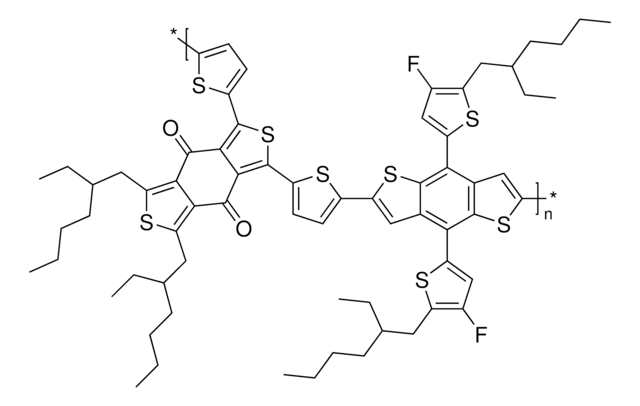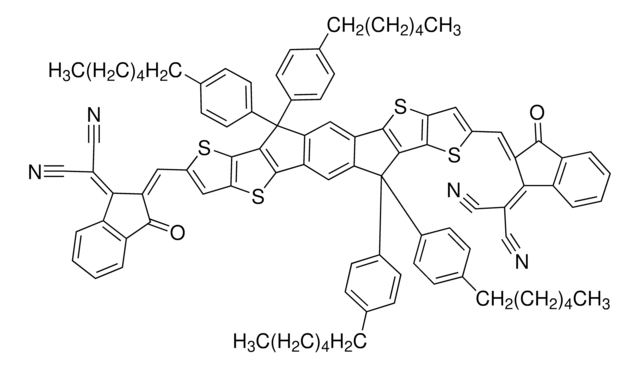906352
PBDB-T-2Cl
동의어(들):
OS0139, PCE 139, PM 7, Poly[[4,8-bis[5-(2-ethylhexyl)-4-chloro-2-thienyl]benzo[1,2-b:4,5-b′]dithiophene-2,6-diyl]-2,5-thiophenediyl[5,7-bis(2-ethylhexyl)-4,8-dioxo-4H,8H-benzo[1,2-c:4,5-c′]dithiophene-1,3-diyl]-2,5-thiophenediyl]
About This Item
추천 제품
설명
Band gap: 1.95 eV
Solubility:Soluble in 1,2-Dichlorobenzene
양식
particles
분자량
50,000-100,000 g/mol by GPC
색상
Fine
solubility
chlorobenzene: soluble
chloroform: soluble
오비탈 에너지
HOMO -5.52 eV
LUMO -3.57 eV
PDI
2‑4
애플리케이션
Polymeric donor material
LUMO=−3.57 eV
HOMO=−5.32 eV
OPV Device Performance :
PBDB-T-2Cl:IT-4F
Voc= 0.86V
Jsc= 21.46 mA/cm2
FF= 0.75
PCE=13.9%
PBDB-T-2Cl (or PM7) is a wide bandgap polymer donor (n-type semiconductor) containing chlorinated thienyl benzodithiophene (BDT-2Cl) used in high performance polymer solar cells (PSCs). PBDB-T-2Cl-based devices exhibit higher open circuit voltage (Voc) than the PBDB-T-2F-based devices, due to lower molecular energy levels of PBDB-T-2Cl, and leading to an outstanding power conversion efficiency of over 14%.
In general, chlorination is more effective than fluorination in downshifting the molecular energy levels and broadening the absorption spectra.
Storage Class Code
11 - Combustible Solids
WGK
WGK 3
Flash Point (°F)
Not applicable
Flash Point (°C)
Not applicable
가장 최신 버전 중 하나를 선택하세요:
이미 열람한 고객
문서
The emerging organic photovoltaic (OPV) technology is very promising for low-cost solar energy production. OPV devices can be produced using high-throughput, large-volume printing methods on lightweight and flexible plastic substrates, making them easy to deploy and use in innovative ways.
The emerging organic photovoltaic (OPV) technology is very promising for low-cost solar energy production.
Professor Chen (Nankai University, China) and his team explain the strategies behind their recent record-breaking organic solar cells, reaching a power conversion efficiency of 17.3%.
Global Trade Item Number
| SKU | GTIN |
|---|---|
| 906352-100MG | 4054839936661 |
자사의 과학자팀은 생명 과학, 재료 과학, 화학 합성, 크로마토그래피, 분석 및 기타 많은 영역을 포함한 모든 과학 분야에 경험이 있습니다..
고객지원팀으로 연락바랍니다.

![[6,6]-Phenyl C61 butyric acid methyl ester ≥99%](/deepweb/assets/sigmaaldrich/product/structures/359/221/d990c746-0960-4c69-bf76-fe09b193824d/640/d990c746-0960-4c69-bf76-fe09b193824d.png)
![[6,6]-Phenyl C71 butyric acid methyl ester, mixture of isomers 99%](/deepweb/assets/sigmaaldrich/product/structures/716/624/9fb9f2f0-ae99-429f-8d3a-b12267976a4d/640/9fb9f2f0-ae99-429f-8d3a-b12267976a4d.png)







![Poly[2-methoxy-5-(2-ethylhexyloxy)-1,4-phenylenevinylene] average Mn 40,000-70,000](/deepweb/assets/sigmaaldrich/product/structures/344/488/b8f8179d-3970-4deb-a754-adda88cdb36f/640/b8f8179d-3970-4deb-a754-adda88cdb36f.png)